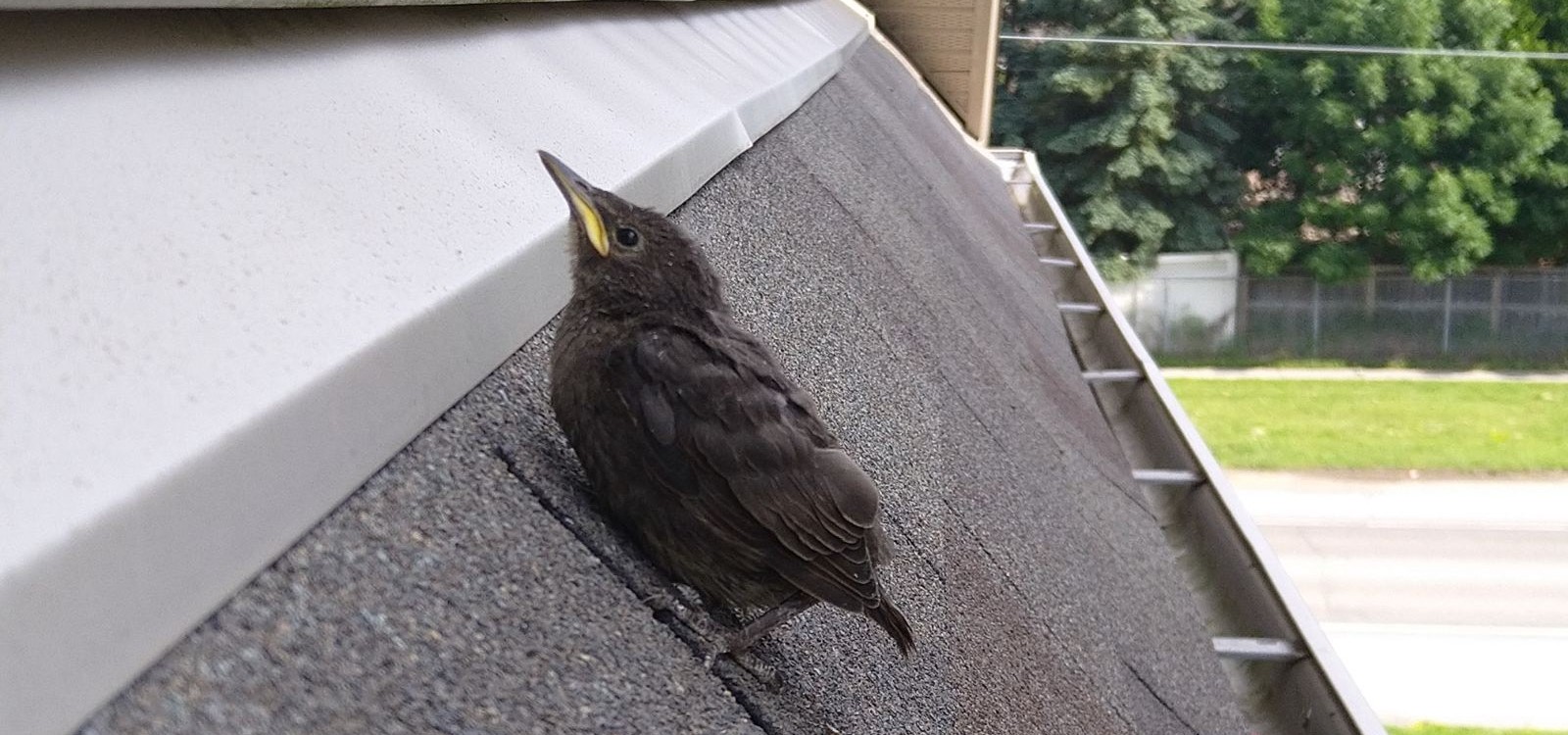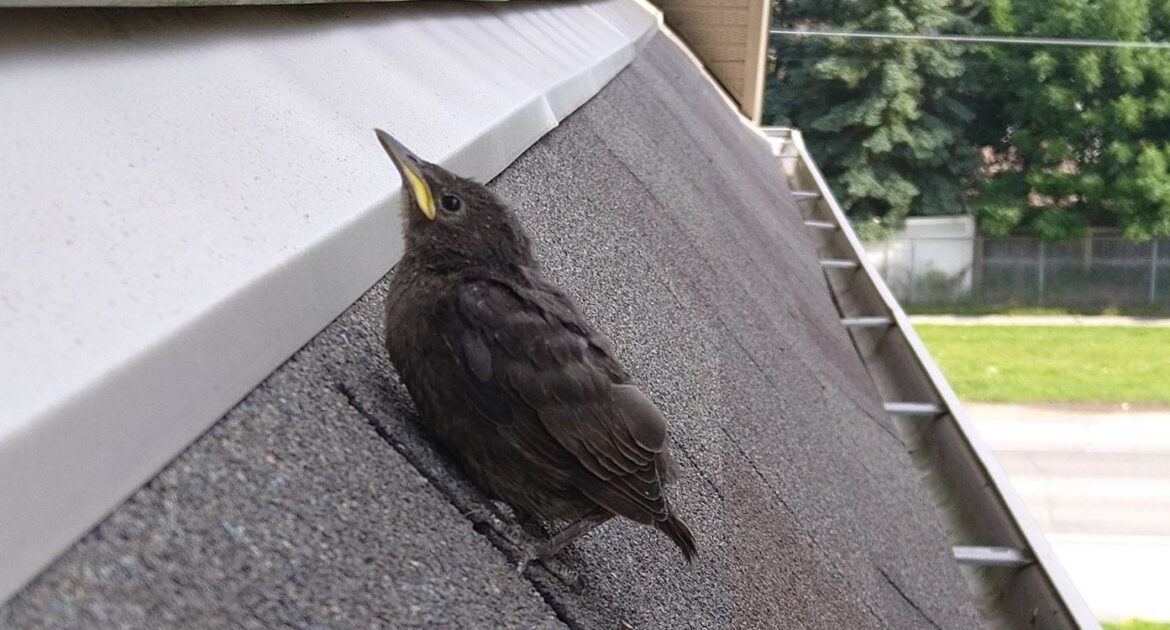Have you ever wondered where birds go when the sun sets? Do they roost in trees, tuck themselves into hidden nooks, or take flight in search of safe shelter? The truth is, bird sleeping habits are as fascinating as they are varied, and understanding where birds sleep at night can offer a whole new appreciation for the wildlife around us.
At Skedaddle Humane Wildlife Control in Hamilton, we often get questions about nighttime bird behaviour, especially from homeowners concerned about birds nesting in unwanted places.
Let’s explore how birds settle in for the night, the different ways they adapt to their surroundings, and how their unique behaviours keep them safe from predators and changing weather.
How Do Birds Sleep?
Birds sleep in some pretty creative ways. Their sleeping habits are shaped by their need for safety and energy conservation. To start, birds have something special called a locking mechanism in their feet. This allows them to perch on branches without falling, even while they’re sleeping. They curl their toes around the branch, and the muscle locks in place, keeping them balanced all night. Isn’t that incredible?
But it’s not just trees. Birds find all kinds of spots to snooze. Where birds sleep depends on their species, location, and whether or not they’re ground dwellers or tree-dwellers. Some shorebirds sleep in shallow water to stay safe from predators. Many urban birds, like pigeons and sparrows, settle in sheltered places like building ledges or under bridges. Meanwhile, certain ducks can even sleep while floating on water. Talk about adaptability!
And, while you might think birds tuck their heads under their wings just to look adorable (which they do), it actually has a practical reason. By covering their beaks with their feathers, birds can hold in body heat, which is especially important during cold nights here in Canada.
Where Exactly Do Birds Sleep at Night?
The location where they rest varies depending on the environment and what kind of bird they are. Here are some common places where birds sleep at night:
- Trees: Many small songbirds like finches and chickadees sleep in trees, as the branches provide a high and relatively safe spot away from predators. Dense evergreen trees are particularly popular because they shield birds from wind, rain, and snow. Birds also choose trees with thick foliage to stay hidden from animals that might hunt them at night.
- Cavities and Holes: Woodpeckers and nuthatches prefer sleeping inside tree cavities or even birdhouses. These spaces protect them from the cold and predators. The enclosed space also helps them stay warm by trapping their body heat during chilly nights.
- Tall Grass or Shrubs: Ground-nesting birds like quails or certain types of sparrows might sleep hidden under shrubs or tall grass. The dense vegetation helps them stay camouflaged. It also provides a soft and quiet place where they can rest without being easily noticed.
- Urban Spaces: City birds, such as pigeons and starlings, commonly sleep in sheltered areas like under roofs, inside abandoned buildings, or under bridges. These spaces offer protection from rain and wind. Urban spots also keep them safe from many natural predators that are less common in cities.
- Water: Birds like ducks and geese sleep on or near water to avoid land-based predators. Floating allows them to rest while staying safe from foxes or raccoons. The water also gives them a quick escape route if they sense danger nearby.
Each species has its unique way of blending into its surroundings to stay as safe and comfortable as possible. Nighttime bird behaviour always revolves around safety, whether it’s about finding protection from predators or keeping warm.
Why Don’t Birds Get Cold While Sleeping?
Here in Hamilton, winters can be harsh, and you might wonder how small birds manage to sleep through freezing temperatures. Unlike us, birds don’t have the luxury of cozy beds and heating systems, but their bodies are built for survival. Their feathers act as natural insulation, trapping heat close to their bodies. To conserve energy, many birds fluff their feathers, creating extra air pockets that help keep them warm. Some species even go into a state of shallow torpor at night, where they lower their body temperature and heart rate to conserve energy.
Birds also pick spots that shield them from the elements. For example, roosting together is another clever tactic. Many birds huddle in groups to share body heat, especially in winter. You might come across stories of dozens of tiny wrens all snuggling into a single nest box for that very reason. Who wouldn’t want their own bird-sized blanket during chilly nights?
How Do Birds Stay Safe from Predators at Night?
Predators don’t take the night off, which is why birds are careful about where they sleep at night. Choosing a high, hidden, or well-sheltered spot is key for staying safe. Birds are surprisingly good at identifying the best locations to roost. For example:
- Camouflaging Spots: Many birds pick places where they blend into their surroundings, such as tree branches or thick bushes.
- Height: Sleeping higher in trees makes it harder for predators like foxes or raccoons to reach them.
- Group Living: Some of these animals sleep in flocks, which not only provides warmth but increases their chances of spotting danger early.
Interestingly, some birds, like owls and night herons, are nocturnal, meaning they hunt at night instead of sleeping. Their role in the ecosystem helps keep populations of rodents and other pests under control.
Bird Sleeping Habits in Your Home
When birds choose their sleeping spots, sometimes the shelter they find is a little too close to our homes. Birds may roost in vents, attics, or even eaves, which can become a problem if they’re difficult to remove or cause damage. That’s where we come in. At Skedaddle Humane Wildlife Control, we ensure these animals are removed in a safe and humane way.
Our trained technicians use one-way doors when wildlife ends up in the wrong places. These doors allow birds to leave the space they’re in, but they can’t return. This method is effective for preventing birds from nesting in your home permanently while also keeping them safe.
Why Bird Habits are a Reason to Act Quickly
If birds disturb structures or make nests in vents and attics, it’s not something to ignore. Their droppings can accumulate and lead to contamination, and nests left behind can attract other pests. Plus, removing wildlife isn’t as simple as you might think. To keep everything safe and humane, professional removal is always the best approach.
By understanding bird sleeping habits, we can handle intrusions and nesting situations more effectively. At Skedaddle in Hamilton, our humane methods ensure both wildlife and homeowners remain safe through the process.
Let Us Help You Keep Birds Where They Belong
Your questions about where birds sleep at night and the amazing variety of nighttime bird behaviour show how interesting our winged neighbours truly are. Still, if birds choose your home for their nightly roost, it’s time to reach out to the experts.
At Skedaddle Humane Wildlife Control in Hamilton, we use safe, humane techniques like one-way doors to remove animals without harm. You can trust us to protect your home while respecting the wildlife around it. Request an estimate today to learn more about how we can help!




